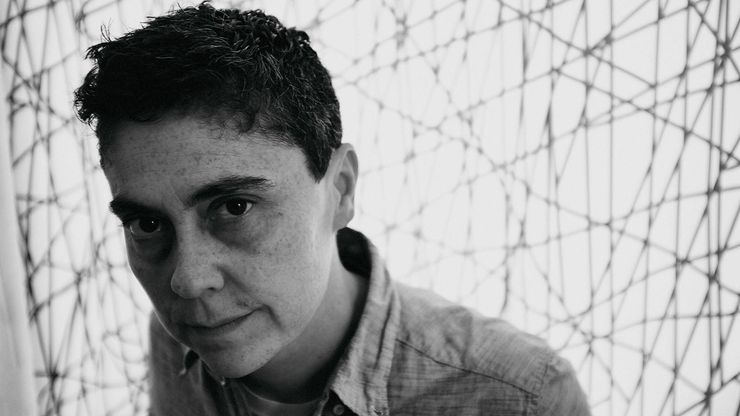Andrea Lawlor on queer culture and their debut novel
Andrea Lawlor, author of Paul Takes the Form of A Mortal Girl,discusses the book's much-talked-about sex scenes and how their life influenced the novel.

Andrea Lawlor’s debut novel, Paul Takes the Form of a Mortal Girl, is a riotous romp through the identity politics and queer subculture of ‘90s America. The hero/ine of the book, Paul Polydoris, is a 23-year-old bartender studying queer theory – who just happens to be a shapeshifter. This secret ability to change body and sex takes him from Chicago leather bars to the Michigan Woymyn’s Music Festival and many places in between. The novel draws on many of Andrea’s own experiences in the ‘90s, from zine culture to the impact of the AIDS crisis. Andrea, who identifies as non-binary and uses they/them pronouns, explains, ‘I sometimes describe the novel as thinly-veiled autobiographical fiction. For instance, the novel starts out in Iowa City in 1993, a place I lived at that time, and Paul journeys to a number of places where I’ve spent time (Provincetown, NYC, Chicago, San Francisco).’ They continue, ‘I gave Paul many of my old jobs (bartending, dishwashing, bookselling, house painting, etc) and traits (I’m decent with an Exact-O knife and rubber cement, for instance, and I like shiny things) – but I think many fiction writers do this sort of thing. I guess I say it’s autobiographical fiction in order to signal that Paul’s shapeshifting is drawn from my own negotiations of social demands around gender. Not all of the book is based on my lived experience, certainly: it’s very much fiction. But many of Paul’s struggles have been my struggles and many of his pleasures my pleasures.’
Paul’s ability to shapeshift allows him to be accepted into many different subcultures, from Riot Grrrl to the leather bar scene, and through Paul’s exploits Andrea opens up the queer worlds they have experienced to the reader. ‘I wasn’t so much intent on telling a particular story or making a particular point, but I did want to faithfully represent the queer worlds I knew. I came of age in a very mixed context – the queer activist scene in NYC in the early ‘90s – and that shaped my understanding of what it might mean to be queer. As a college student, I got involved with Queer Nation, ACT UP, the Pink Panthers – all these explicitly coalitional groups.’ Andrea was always drawn to the word queer as an expression of their identity, explaining that, ‘I had never identified as a lesbian; I liked how the word “queer” signalled transgressive desire without gendering me. I hung out with lots of queer men, and found something closer to my reflection in gay male culture, probably because I could identify with the combination of queerness and masculinity more than with lesbian culture (though I was primarily dating lesbians). I wasn’t interested in lesbian separatist spaces at all, and certainly never went to Michigan – I had what I thought at the time was an aesthetic aversion but which I think now was a feeling of being wrongly welcomed, if that makes sense. I didn’t feel excluded as much as misunderstood. Later I came to understand the ways in which Michigan, for example, was excluding trans women, and then my objections became largely political.’
Despite the novel taking 15 years for Andrea to write it couldn’t feel more timely, as trans issues continue to be under the spotlight in 2019. As a joyful celebration of gender fluidity, Andrea hopes that the novel will contribute to the conversation around gender identity and sexuality. They explain, ‘I mostly hope this book can be one book among many, a book that depicts a particular scene, a particular moment, a particular but not representative queer way of being a person. And yet, as queers we often do spend much of our time with people of our own generation. When we can break out of that, we have so much to say to each other, so much to learn from each others’ experiences. I’m delighted when younger queers are interested in the 90s. That curiosity makes sense to me, as I was fascinated by queer life in the 60s, 70s, 80s when I was younger. And I love reading stories about what it’s like to be young and queer/trans now, seeing what’s different, what’s the same, what’s new.
And the much talked about sex scenes? ‘I wanted to write a book that depicted a world I knew and what can I say? I like pleasure! I mean, I’m queer because I find it fun to be queer, not because it makes me feel virtuous to be queer, not because I was “born this way.” I don’t care at all about why I’m queer; I feel very lucky to have this life, and that’s it. Of course, many of us have struggled mightily, and we also have access to such particular pleasures, so many cultural traditions centred around sex and art and beauty and new ways of doing things. As the Pet Shop Boys said, “we were never being boring.”’
Paul Takes the Form of A Mortal Girl
by Andrea Lawlor
Paul Takes the Form of A Mortal Girl is a riotous journey through early ‘90s identity politics, told from the point of view of Paul, a bartender and student of queer theory who possesses the ability to shapeshift, changing his body and sex at will.
Delve into the best queer YA books for inspiring stories that celebrate diversity.



